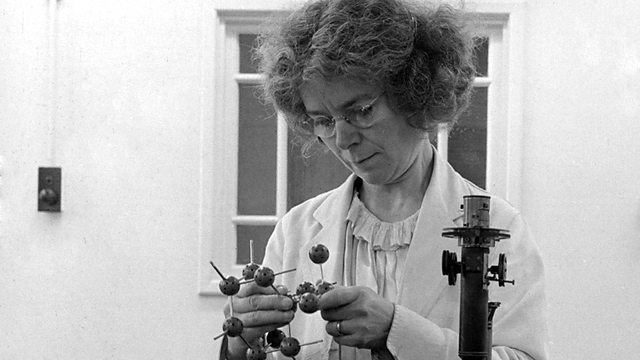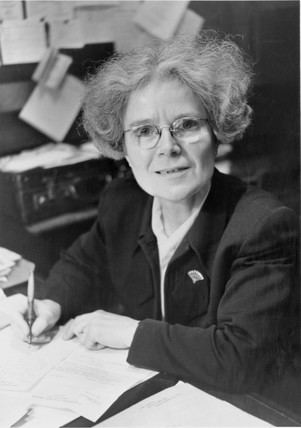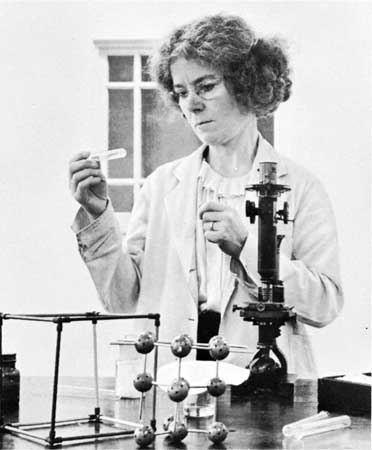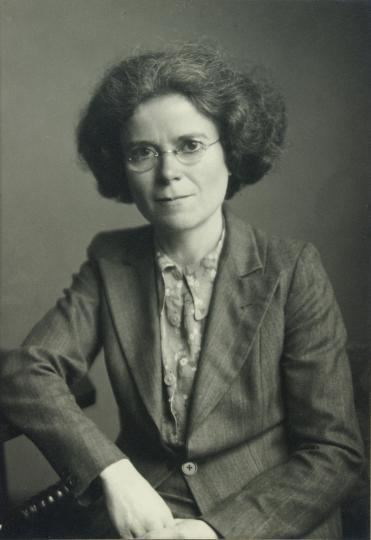Fields Crystallographer Known for X-ray crystallography | Role Crystallographer Name Kathleen Lonsdale | |
 | ||
Born Kathleen Yardley28 January 1903Newbridge, County Kildare, Ireland ( 1903-01-28 ) Institutions University College LondonRoyal InstitutionUniversity of Leeds Alma mater Bedford College for WomenUniversity College London Notable awards Davy Medal (1957)Fellow of the Royal Society Died April 1, 1971, London, United Kingdom Books Science, Religion and the Student Education Royal Holloway, University of London Similar People William Henry Bragg, William Lawrence Bragg, Melvyn Bragg, John Macmurray | ||
Doctoral advisor William Henry Bragg | ||
Crystallographers in conference 1965 kathleen lonsdale
Dame Kathleen Lonsdale, DBE, FRS (née Yardley; 28 January 1903 – 1 April 1971) was a British crystallographer who proved, in 1929, that the benzene ring is flat by using X-ray diffraction methods to elucidate the structure of hexamethylbenzene. She was the first to use Fourier spectral methods while solving the structure of hexachlorobenzene in 1931. During her career she attained several firsts for female scientists, including being one of the first two women elected a Fellow of the Royal Society (FRS) in 1945 (along with Marjory Stephenson), first woman tenured professor at University College London, first woman president of the International Union of Crystallography, and first woman president of the British Association for the Advancement of Science.
Contents
- Crystallographers in conference 1965 kathleen lonsdale
- David Attenborough Visit to UCL Kathleen Lonsdale Reopening
- Early life and education
- Career and research
- Selected publications
- Legacy and honours
- Personal life
- Pacifism
- Death
- References
David Attenborough Visit to UCL - Kathleen Lonsdale Reopening
Early life and education

She was born Kathleen Yardley at Newbridge, County Kildare, Ireland, the tenth child of Harry Yardley, the town postmaster, and Jessie Cameron. Her family moved to Seven Kings, Essex, England, when she was five years old. She studied at Woodford County High School for Girls, then transferred to Ilford County High School for Boys to study mathematics and science, because the girls' school did not offer these subjects. She earned her Bachelor of Science degree from Bedford College for Women in 1922, graduating in physics with an MSc from University College London in 1924.
Career and research

In 1924 she joined the crystallography research team headed by William Henry Bragg at the Royal Institution. After her marriage, Lonsdale worked at the University of Leeds in the late 1920s. During the early 1930s, she cared for her small children nearly full-time.

In 1934 Lonsdale returned to work with Bragg at the Royal Institution as a researcher. She was awarded a DSc from University College London in 1936 while at the Royal Institution. In addition to discovering the structure of benzene and hexachlorobenzene, Lonsdale worked on the synthesis of diamonds. She was a pioneer in the use of X-rays to study crystals. Lonsdale one of the first two women elected a Fellow of the Royal Society (FRS) in 1945 (the other was the biochemist Marjory Stephenson).
In 1949 Lonsdale was appointed professor of chemistry and head of the Department of Crystallography at University College, London. Among her students was Karimat El-Sayed who became a Professor of Crystallography in Egypt. On a more personal level El-Sayed credits Lonsdale with demonstrating to her how a career and a family could be balanced. She was the first tenured woman professor at that college, a position she held until 1968 when she was named Professor Emeritus.
Selected publications
Legacy and honours
Personal life
After beginning her research career, in 1927 Yardley married Thomas Jackson Lonsdale. They had three children – Jane, Nancy, and Stephen. Stephen became a medical doctor and worked for several years in Nyasaland (now Malawi).
Pacifism
Though she had been brought up in the Baptist denomination as a child, Kathleen Lonsdale became a Quaker in 1935, simultaneously with her husband. Already committed pacifists, both were attracted to Quakerism for this reason. She was a Sponsor of the Peace Pledge Union.
She served a month in Holloway prison during the Second World War because she refused to register for civil defence duties, or to pay a fine for refusing to register. During this time she experienced a range of issues which would eventually result in Lonsdale becoming a prison reform activist and she joined the Howard League for Penal Reform
"What I was not prepared for was the general insanity of an administrative system in which lip service is paid to the idea of segregation and the ideal of reform, when in practise the opportunities for contamination and infection are innumerable, and those responsible for re-education practically nil"
In 1953, at the annual meeting of the British Quakers, she delivered the keynote Swarthmore Lecture, under the title Removing the Causes of War. A self-identified Christian pacifist, she wrote about peaceful dialogue and was appointed the first secretary of Churches' Council of Healing by the Archbishop of Canterbury William Temple.
Death
Lonsdale died on 1 April 1971, aged 68, from an anaplastic cancer of unknown origin.
